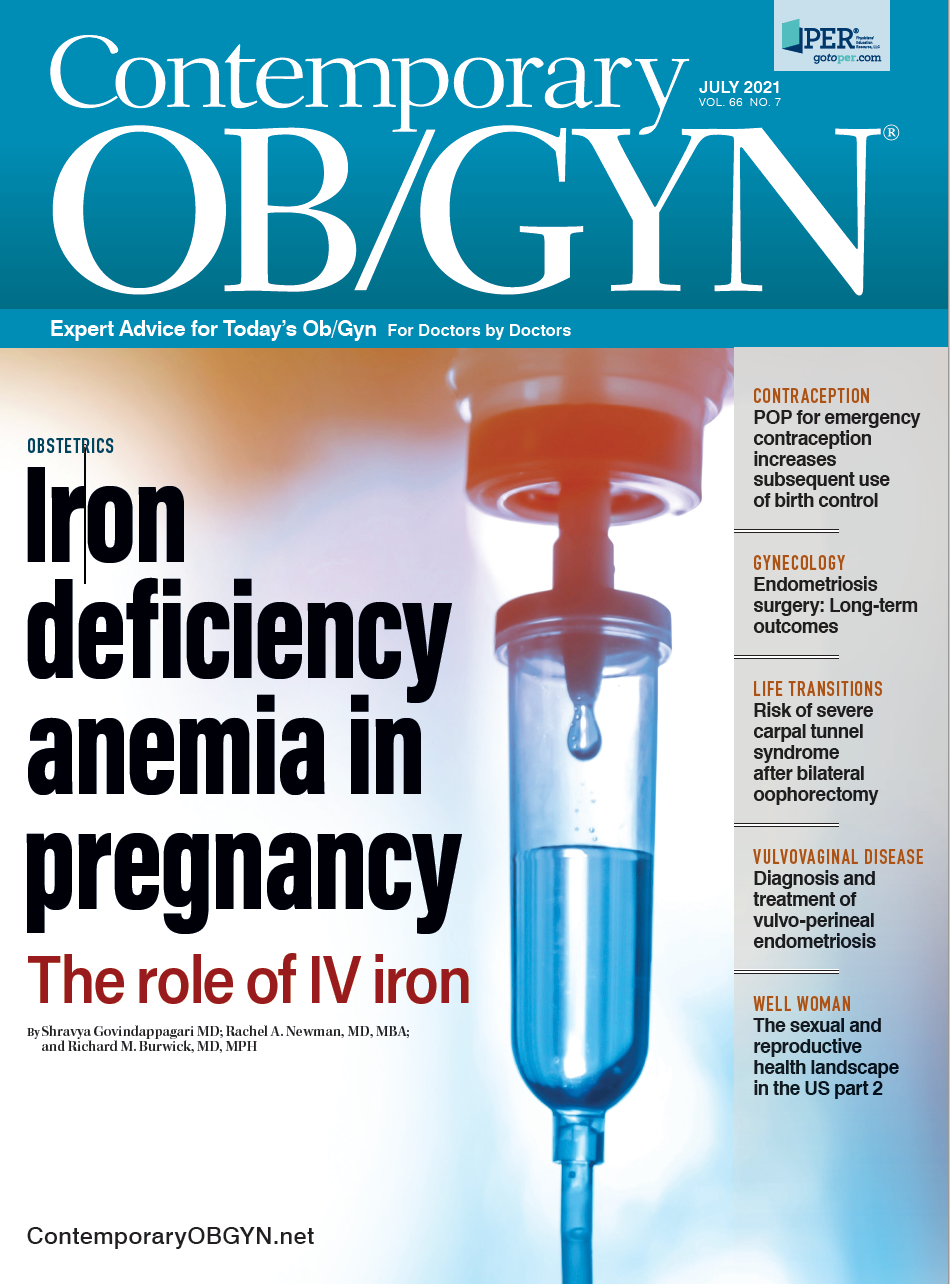Iron-deficiency anemia in pregnancy and the role of intravenous iron
Anemia in pregnancy should be treated due to its connection to adverse maternal and neonatal outcomes.
Anemia, a condition in which the number of red blood cells is insufficient to meet the body’s physiologic needs for oxygen transport, affects more than one-third of reproductive-age women worldwide.1 The World Health Assembly Resolution 65.6 endorsed a comprehensive implementation plan on maternal, infant and young child nutrition.
Although there are many etiologies of anemia, ranging from chronic disease to acute blood loss, it is estimated that 50% of the anemia seen in pregnancy is due to iron deficiency.2 Based on guidelines set forth by the World Health Organization (WHO), anemia is defined as mild (hemoglobin level, 10-11 g/dL), moderate (hemoglobin level, 8.5-10 g/dL), and severe (hemoglobin level < 8.5 g/dL).2
By this definition, data from the National Health and Nutrition Examination Survey demonstrated that in the United States, 8.8% of pregnant women develop anemia at some point during their pregnancies, with approximately half of this cohort having a hemoglobin level of less than 10 g/dL.3 Risk of anemia increases by gestational age, and by the third trimester, 30% of pregnant women are iron deficient.4
The prevalence of anemia is a significant public health indicator. Even though anemia is primarily caused by iron deficiency, low oxygen-carrying capacity may result from other conditions such as chronic diseases, which remain a relevant health concern in the US. However, studies examining current rates of anemia in the total US population and in more specific subgroups are limited.
Anemia in pregnancy should be treated because numerous studies have shown that moderate to severe anemia is associated with adverse maternal and neonatal outcomes.5-9 A secondary analysis of the Consortium on Safe Labor data from the Eunice Kennedy Shriver National Institute of Child Health and Human Development found that women with antepartum anemia experienced increased rates of severe maternal morbidity (eg, death, transfusion, hysterectomy) and adverse neonatal outcomes, and these findings persisted after adjustment for confounding factors.5
Table 1. Elemental Iron Content and Adverse Effects in Select Oral Iron Formulations16
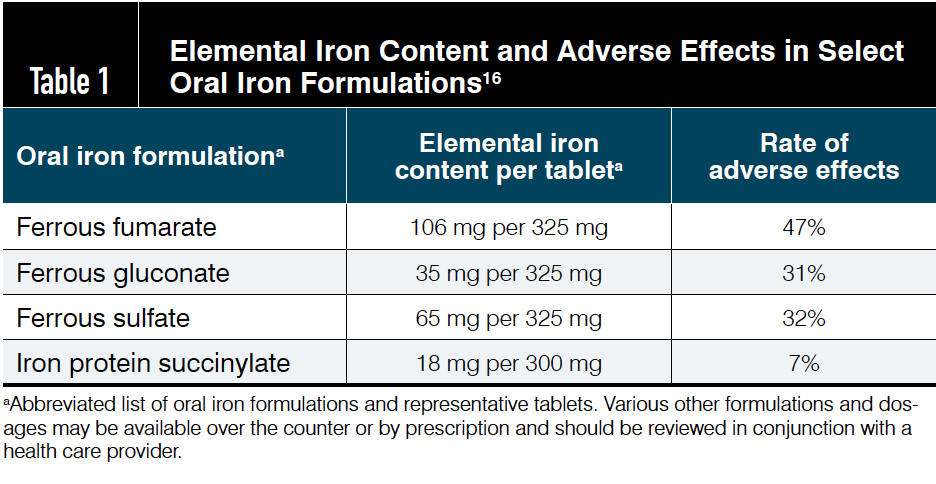
Although data regarding the positive effect of iron supplementation on maternal and infant outcomes are limited, a 2015 Cochrane review found that preventive iron supplementation reduced maternal anemia at term by 70% and iron deficiency at term by 57%.10 Therefore, identification and treatment of anemia in pregnancy are of paramount importance and may serve as a preventive measure for seemingly distinct causes of severe maternal and neonatal morbidity.
Diagnosis of anemia is the first crucial step in its management, with the WHO definitions of anemia generally adhered to in the clinical setting. However, the diagnosis of iron-deficiency anemia both in and outside of pregnancy is less clear. At the initiation of prenatal care, each patient has a complete blood count collected.
If the hemoglobin level is less than 11 g/dL, the next step is to determine the cause of anemia. The differential diagnosis is broad, especially in those with chronic medical conditions. However, since iron deficiency is the most common cause of anemia in pregnancy, most experts recommend beginning the evaluation with a serum ferritin level.
Although there are several markers to assess total body iron stores—such as total serum iron, transferrin saturation, serum transferrin receptor, and total iron-binding capacity—a serum ferritin level of less than or equal to 30 ng/mL is 92% sensitive and 98% specific for diagnosing iron deficiency.11
Much of the early literature on ferritin used a value of less than or equal to 12 ng/mL to define iron deficiency. However, newer studies have shown that although this ferritin threshold has high specificity (98%) for iron deficiency, it has poor sensitivity (25%), meaning that many diagnoses would be missed.12,13
Unfortunately, it is not uncommon for laboratories to use very low ferritin levels to define iron deficiency, even among pregnant women. Thus, it is imperative that the ordering provider look at the absolute ferritin value and interpret it in the context of the clinical picture, rather than depending on the laboratory to flag the result as normal or abnormal.
If the ferritin level is less than or equal to 30 ng/mL, the diagnosis of iron deficiency can be made. However, if the hemoglobin level is less than 11 g/dL and the ferritin is more than 30 ng/mL, the diagnosis remains uncertain. In such cases, other iron studies may be supportive of iron deficiency (such as total iron saturation<20%).
The mean corpuscular volume (MCV) is also useful to guide the next step in the evaluation. If the MCV is less than 80 fL, it is consistent with microcytic anemia, and the differential diagnosis primarily includes iron deficiency and hemoglobinopathy (sickle cell anemia, thalassemia). Hemoglobin electrophoresis and α-thalassemia testing may be performed to rule out underlying hemoglobinopathy as a cause of the anemia.
If there is no hemoglobinopathy and ferritin is more than 30 ng/ml, referral to a hematologist may also be considered to investigate the cause of anemia. If the MCV is more than 90 to 100 fL, macrocytic anemia is suspected, and testing may include work-up for folate or B12 deficiency.
Once iron deficiency has been identified, the next step is treatment. Although the nonpregnant woman requires approximately 18 mg of elemental iron daily, pregnant patients should be ingesting approximately 30 mg daily.14,15 This increased requirement in pregnancy is due to the expansion of maternal blood volume and fetal erythroid mass.
To achieve the necessary amount of daily iron, additional supplementation is often necessary for pregnant women, especially those with anemia. For women with mild to moderate anemia in the first or second trimester of pregnancy (<28 weeks’ gestation), the first-line treatment for iron deficiency is a combination of improved dietary intake and oral iron supplements.
The American College of Obstetricians and Gynecologists recommends that providers and their patients discuss ingestion of iron-rich foods, including shrimp, turkey, enriched cereals, beans, lentils, liver, oysters, and clams.15 It is also worth reviewing foods that impair iron absorption, such as dairy and soy products, spinach, and coffee or tea.15
In addition to dietary modifications, patients should also be started on an oral iron supplement.
Common formulations including elemental iron content and adverse effects are shown in Table 1.16 There are various iron formulations, such as ferrous sulfate, ferrous fumarate, ferrous gluconate, ferrous glycine sulfate, and ferrous sulfate coated with mucoproteose. Ferrous sulfate is commonly used due to its wide availability and low cost; however, a systematic review comparing different formulations of oral iron found that ferrous glycine coated with mucoproteose is best tolerated.16 The most common dosage of all formulations is 325 mg, which will contain between 35 and 106 mg of elemental iron per pill. The maximum enteral absorption of iron is between 20% and 30%, but on average, the typical absorption of iron is between 10% and 15%.14 Therefore, for a 325-mg tablet of ferrous sulfate that contains 65 mg of elemental iron, only 6.5 to 9.75 mg of iron will be absorbed.17
Oral iron is the first-line supplementation; however, its efficacy often is limited by poor intestinal absorption. Unfortunately, increasing the dose of oral iron does not improve efficacy. This was shown in a randomized controlled trial (RCT) comparing 1 versus 2 daily capsules of ferrous sulfate (34-mg elemental iron per capsule) for treatment of iron-deficiency anemia in pregnancy. After 18 weeks of treatment, there was no difference in hemoglobin and ferritin levels between women taking 1 or 2 capsules daily.
A possible explanation is that higher and more frequent doses of oral iron leads to increased production of the hormone hepcidin, which inhibits dietary iron absorption to prevent further iron loading.18,19 For this reason, some experts have begun recommending alternate-day dosing (taking iron every other day rather than every day) because it appears to result in equivalent or better iron absorption with fewer adverse effects.20
Oral iron supplements are often poorly tolerated by patients, with common adverse effects such as nausea and constipation. In such cases, alternate-day dosing of oral iron may be particularly helpful to reduce side effects and increase compliance, compared with daily or twice-daily dosing.18,20
To further decrease adverse effects, patients often seek enteric-coated or timed-release formulations of oral iron, but these may have reduced absorption in the distal duodenum and proximal jejunum, impairing treatment. Historically, it also has been taught that oral iron may have enhanced absorption when taken together with a vitamin C supplement, but a recent RCT found that this approach provided no benefit compared with oral iron alone.21
Table 2. IV Iron Formulations and Standard Dosing and Monitoring Recommendations
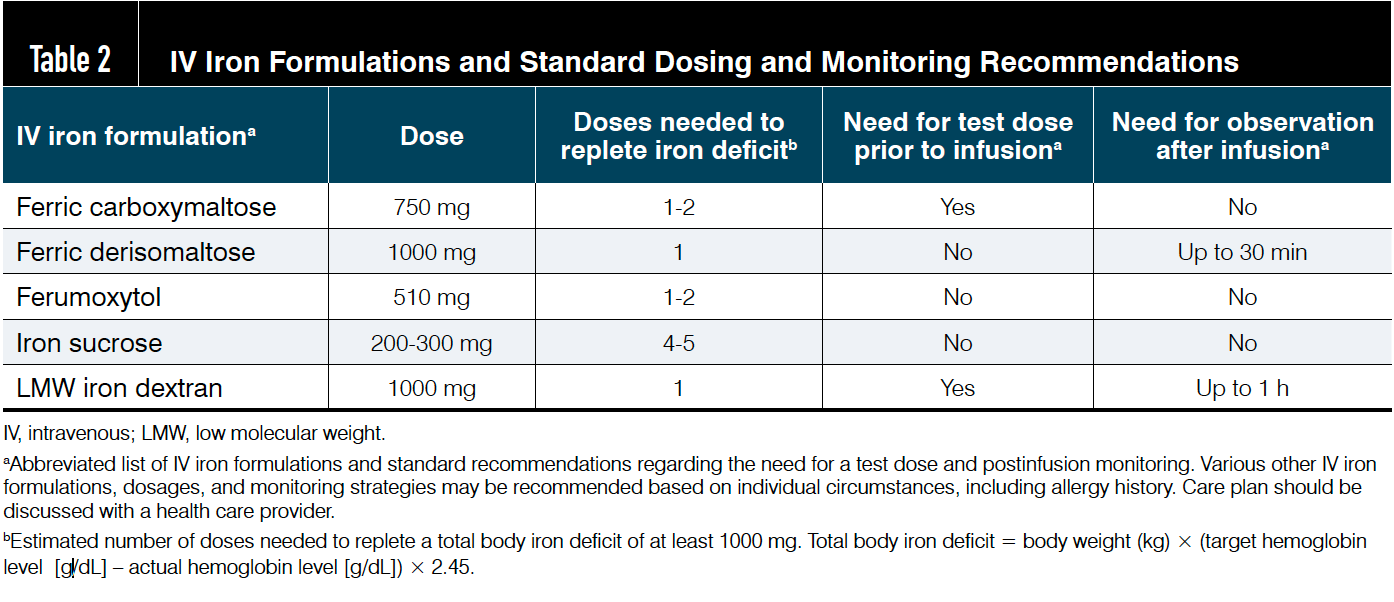
Intravenous (IV) iron formulation, which bypasses the limited intestinal absorption of oral formulations, is becoming an increasingly available option for patients with iron deficiency. IV iron may increase iron stores more quickly than oral iron, but it remains underutilized in pregnancy due to cost and perceptions of risk.22 Like oral iron, numerous IV iron formulations are available with various dosing and monitoring recommendations (Table 2).
Iron sucrose is the most widely available option, particularly in the hospital setting, and it has a long history of use in pregnant women with a favorable safety profile. The primary drawback with iron sucrose is that unlike newer IV iron formulations, which may require only 1 or 2 infusions, iron sucrose is a multidose regimen that usually requires 4 or 5 infusions to replete iron stores, depending on the total iron deficit. Most pregnant women with moderate to severe iron-deficiency anemia have an iron deficit of 1000 mg or more, but the calculation of total body iron deficit (bodyweight in kg×[target hemoglobin level – actual hemoglobin level in g/dL]×2.45) can help determine the exact need.
Figure 1. Meta-analysis of Randomized Controlled Trials Among Pregnant Women With Iron-deficiency Anemia Treated With IV Iron Compared to Oral Iron22,a
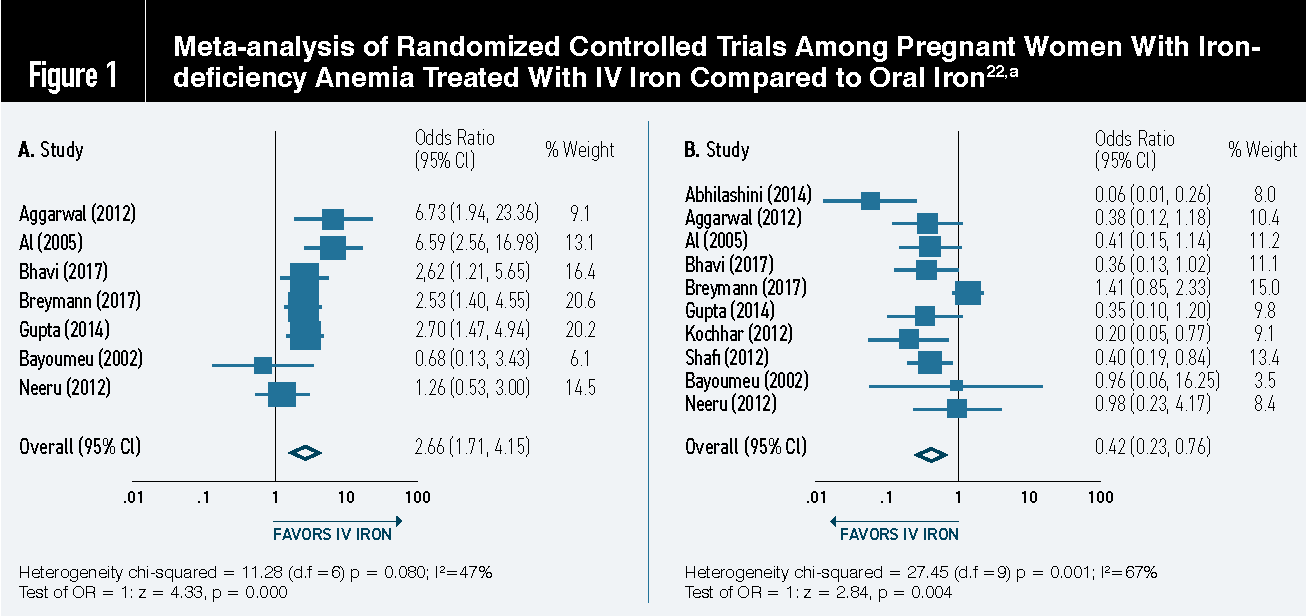
Historically, there has been a safety concern about the use of IV iron due to the potential risk of serious and fatal anaphylaxis.15,23 The risk was highest with high molecular weight iron dextran, but this formulation is no longer available. With contemporary formulations of low molecular weight iron dextran, the risk of anaphylaxis is lower and estimated at 82 cases per 100,000 persons compared with 21 cases per 100,000 persons taking iron sucrose.23
Since the initial use of IV iron for treatment of anemia in pregnancy, numerous clinical trials of IV iron in pregnant women have been performed comparing the efficacy and safety of IV iron with oral iron.
A systematic review and meta-analysis comparing IV iron with oral iron for treatment of iron-deficiency anemia in pregnancy found that IV iron is superior to oral iron for treatment of anemia in pregnancy (Figure 1).22 Pregnant women receiving IV iron were 2.7 times more likely to achieve target hemoglobin levels than women taking oral iron after 4 weeks of treatment.22
Similarly, women in the IV iron group reached higher hemoglobin levels after 4 weeks compared with women in the oral iron group. Moreover, pregnant women treated with IV iron had lower rates of adverse events compared with those taking oral iron, primarily due to a lower rate of gastrointestinal adverse effects.22
Another systematic review and meta-analysis looking at the benefits of IV iron for treatment of postpartum anemia also concluded that women receiving IV iron had higher hemoglobin and ferritin concentrations at postpartum weeks 1, 2, 3, 4, and 6 compared with women taking iron orally or by mouth.24
In our practice, we developed a clinical algorithm for diagnosis and management of iron-deficiency anemia in pregnancy (Figure 2). However, we recognize that guidelines may vary by patient population and practice setting and that the cost and availability of various IV iron formulations may differ in the inpatient or outpatient setting.
Figure 2. Proposed algorithm for diagnosis and management of iron-deficiency anemia in pregnancya
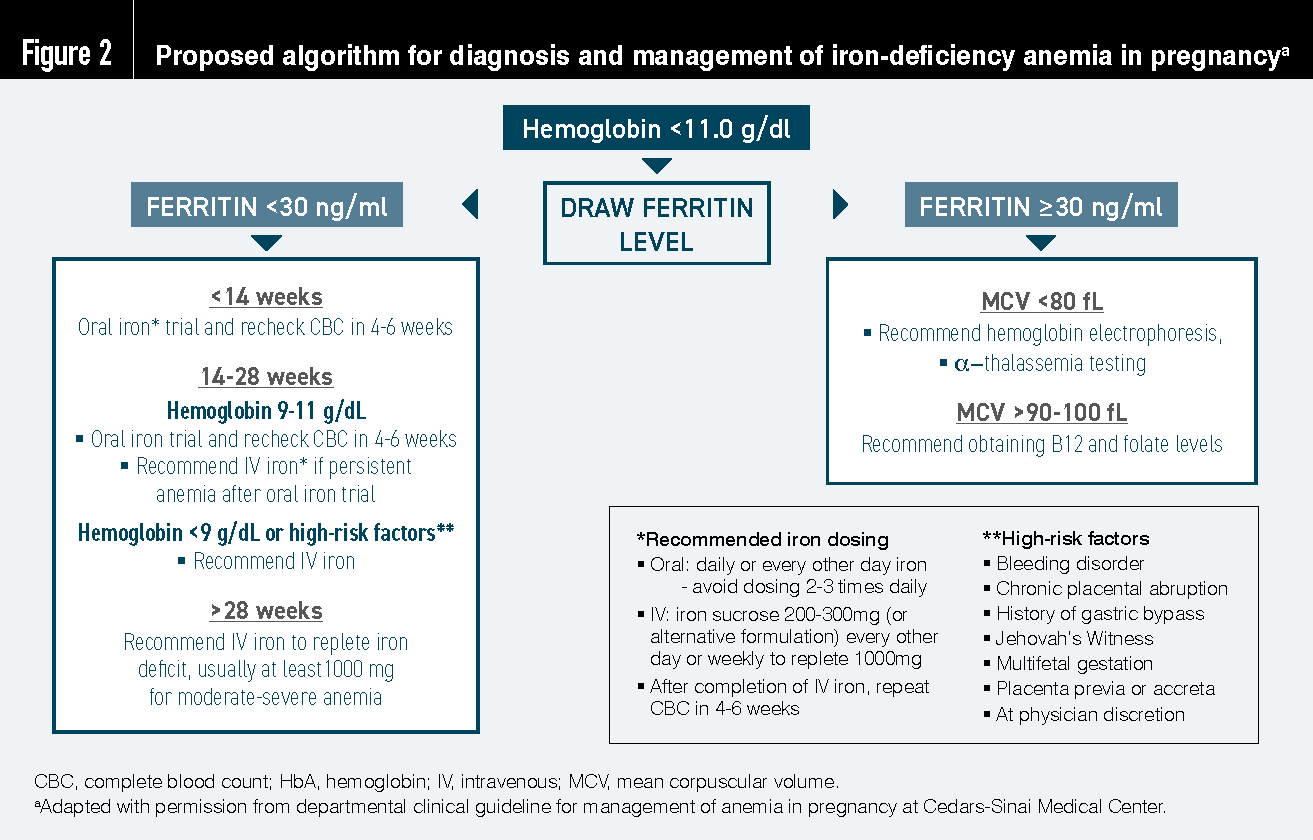
For example, an analysis of private insurance claims conducted by the Health Care Cost Institute found that in 2017, private health plans paid between $412 and $4316 per visit for an infusion of IV iron.25 For women in their first or second trimesters with iron-deficiency anemia, we recommend dietary counseling and a trial of oral iron supplementation. The hemoglobin level should be reassessed in 4 to 6 weeks after initiation of treatment. If the patient remains iron deficient and is not demonstrating a response to oral iron supplements, it is reasonable to initiate treatment with IV iron.
Prior to treating with IV iron, it is important to rule out hemoglobinopathy or folate and B12 deficiency, as indicated by the MCV and degree of anemia. For pregnant women with iron-deficiency anemia in the third trimester—or earlier for those with significant risk factors such as prior bariatric surgery or multifetal gestation—IV iron should be given to replete iron stores more quickly in preparation for delivery. Providers should target a hemoglobin level of more than 10 g/dL by delivery to reduce the risk for postpartum hemorrhage and blood transfusion.
Targeting a hemoglobin level of more than 11 g/dL or complete resolution of anemia may be preferred in those with an objection to blood products or at high risk for blood transfusions, such as those with a bleeding disorder, placenta previa or accreta, or multiple prior cesarean deliveries.
To conclude, iron-deficiency anemia is a global disease of which pregnant women bear a significant burden. Fortunately, iron-deficiency anemia is a treatable condition when managed appropriately in a systematic fashion.
Treatment of iron deficiency in pregnant women is widely accepted, but IV iron formulations should be considered more often when dietary interventions and oral iron supplements have failed to resolve the anemia.
Importantly, this approach is expected to decrease the risk of adverse maternal and neonatal outcomes, decrease the rate of blood transfusion, and improve overall maternal well-being before and after delivery.
References
1. World Health Organization. WHO global nutrition targets 2025: anemia policy brief. December 20, 2014. Accessed June 21 ,2021. https://www.who.int/publications/i/item/WHO-NMH-NHD-14.2
2. Anaemia. World Health Organization. Accessed June 21, 2021. http://www.who.int/topics/anaemia/en/
3. Le CH. The prevalence of anemia and moderate-severe anemia in the US population (NHANES 2003-2012). PLoS One. 2016;11(11):e0166635. doi:10.1371/journal.pone.0166635
4. Mei Z, Cogswell ME, Looker AC, et al. Assessment of iron status in US pregnant women from the National Health and Nutrition Examination Survey (NHANES), 1999-2006. Am J Clin Nutr. 2011;93(6):1312-1320. doi:10.3945/ajcn.110.007195
5. Harrison RK, Lauhon SR, Colvin ZA, McIntosh JJ. Maternal anemia and severe maternal morbidity in a United States cohort. Am J Obstet Gynecol MFM. Published online May 13, 2021. doi:10.1016/j.ajogmf.2021.100395
6. Imdad A, Bhutta ZA. Routine iron/folate supplementation during pregnancy: effect on maternal anaemia and birth outcomes. Paediatr Perinat Epidemiol. 2012;26(suppl 1):168-177. doi:10.1111/j.1365-3016.2012.01312.x
7. Perez EM, Hendricks MK, Beard JL., et al. Mother-infant interactions and infant development are altered by maternal iron deficiency anemia. J Nutr. 2005;135(4):850-855. doi:10.1093/jn/135.4.850
8. Parks S, Hoffman MK, Goudar SS, et al. Maternal anaemia and maternal, fetal, and neonatal outcomes in a prospective cohort study in India and Pakistan. BJOG. 2019;126(6):737-743. doi:10.1111/1471-0528.15585
9. Haider BA, Olofin I, Wang M, Spiegelman D, Ezzati M, Fawzi WW; Nutrition Impact Model Study Group (anaemia). Anaemia, prenatal iron use, and risk of adverse pregnancy outcomes: systematic review and meta-analysis. BMJ. 2013;346:f3443. doi:10.1136/bmj.f3443
10. Peña-Rosas JP, De-Regil LM, Garcia-Casal MN, Dowswell T. Daily oral iron supplementation during pregnancy. Cochrane Database Syst Rev. 2015;22(7):CD004736. doi:10.1002/14651858.CD004736.pub5
11. Achebe MM, Gafter-Gvili A. How I treat anemia in pregnancy: iron, cobalamin, and folate. Blood. 2017;129(8):940-949. doi:10.1182/blood-2016-08-672246
12. Goodnough LT, Nemeth E, Ganz T. Detection, evaluation, and management of iron-restricted erythropoiesis. Blood. 2010;116(23):4754-4761. doi:10.1182/blood-2010-05-286260
13. Ali MA, Luxton AW, Walker WH. Serum ferritin concentration and bone marrow iron stores: a prospective study. Can Med Assoc J. 1978;118(8):945-946.
14. Centers for Disease Control and Prevention. Recommendations to prevent and control iron deficiency in the United States. MMWR Recomm Rep. 1998;47(RR-3):1-29.
15. American College of Obstetricians and Gynecologists. ACOG practice bulletin no. 95: anemia in pregnancy. Obstet Gynecol. 2008;112(1):201-207. doi:10.1097/AOG.0b013e3181809c0d
16. Cancelo-Hidalgo MJ, Castelo-Branco C, Palacios S, et al. Tolerability of different oral iron supplements: a systematic review. Curr Med Res Opin. 2013;29(4):291-303. doi:10.1185/03007995.2012.761599
17. Shinar S, Skornick-Rapaport A, Maslovitz S. Iron supplementation in singleton pregnancy: is there a benefit to doubling the dose of elemental iron in iron-deficient pregnant women? a randomized controlled trial. J Perinatol. 2017;37(7):782-786. doi:10.1038/jp.2017.43
18. Moretti D, Goede JS, Zeder C, et al. Oral iron supplements increase hepcidin and decrease iron absorption from daily or twice-daily doses in iron-depleted young women. Blood. 2015;126(17):1981-1989. doi:10.1182/blood-2015-05-642223
19. Ganz T, Nemeth E. Iron imports. IV. hepcidin and regulation of body iron metabolism. Am J Physiol Gastrointest Liver Physiol. 2006;290(2):G199-G203. doi:10.1152/ajpgi.00412.2005
20. Stoffel NU, Zeder C, Brittenham GM, Moretti D, Zimmermann MB. Iron absorption from supplements is greater with alternate day than with consecutive day dosing in iron-deficient anemic women. Haematologica. 2020;105(5):1232-1239. doi:10.3324/HAEMATOL.2019.220830
21. Li N, Zhao G, Wu W, et al. The efficacy and safety of vitamin C for iron supplementation in adult patients with iron deficiency anemia: a randomized clinical trial. JAMA Netw Open. 2020;3(11):e2023644. doi:10.1001/jamanetworkopen.2020.23644
22. Govindappagari S, Burwick RM. Treatment of iron deficiency anemia in pregnancy with intravenous versus oral iron: systematic review and meta-analysis. Am J Perinatol. 2019;36(4):366-376. doi:10.1055/s-0038-1668555
23. Wang C, Graham DJ, Kane RC, et al. Comparative risk of anaphylactic reactions associated with intravenous iron products. JAMA. 2015;314(19):2062-2068. doi:10.1001/jama.2015.15572
24. Sultan P, Bampoe S, Shah R, et al. Oral vs intravenous iron therapy for postpartum anemia: a systematic review and meta-analysis. Am J Obstet Gynecol. 2019;221(1):19-29.e3. doi:10.1016/j.ajog.2018.12.016
25.Luthra, S. NPR: $2,733 to treat iron-poor blood? iron infusions for anemia under scrutiny. Health Care Cost Institute. August 1, 2019. Accessed June 21, 2021. https://healthcostinstitute.org/in-the-news/npr-2-733-to-treat-iron-poor-blood-iron-infusions-for-anemia-under-scrutiny
